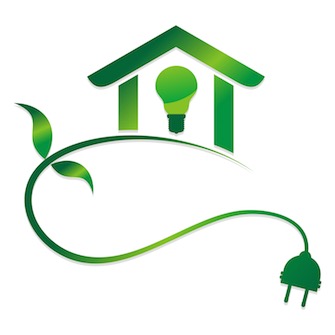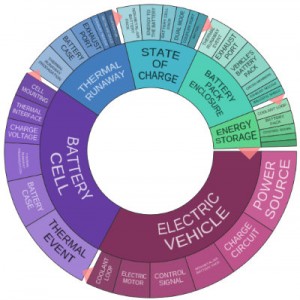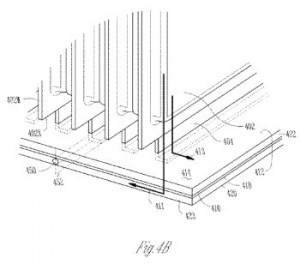 On Thursday, April 30th, Elon Musk of Tesla Motors unveiled a new product which heralded a new direction for the company as well as an energy technology which could prove to be incredibly disruptive to energy utilities as we know them. The Powerwall is marketed as “energy storage for a sustainable home” and it could allow a homeowner to store power generated by alternative forms of energy, even selling some back to the electrical grid if there’s any extra. Instead of a monthly energy bill, some homeowners in the future could be experiencing a monthly energy profit.
On Thursday, April 30th, Elon Musk of Tesla Motors unveiled a new product which heralded a new direction for the company as well as an energy technology which could prove to be incredibly disruptive to energy utilities as we know them. The Powerwall is marketed as “energy storage for a sustainable home” and it could allow a homeowner to store power generated by alternative forms of energy, even selling some back to the electrical grid if there’s any extra. Instead of a monthly energy bill, some homeowners in the future could be experiencing a monthly energy profit.
Tesla’s Powerwall batteries will come in two varieties: one a 10 kilowatt-hour (kWh) version for a weekly cycle unit designed for backup applications, the other a 7 kWh unit for everyday use. The batteries can be installed in groups of up to nine, providing a maximum of 90 kWh hours of backup energy (or 63 kWh of energy available daily). The dimensions of the Powerwall battery are about four feet tall and nearly three feet wide; its slender 7.1 inches of depth and sleek design gives it a form which fits neatly on most walls, inside or out. It can be installed in an afternoon and does not need major home rewiring. The 10 kWh model costs $3,500 ($3,000 for the 7 kWh version) although a homeowner must pay for installation and an inverter if the property includes solar panels.
A press kit developed by Tesla Energy, the division of Tesla developing and marketing the Powerwall, showcases the value of a technology that can help home and business owners control energy costs in spite of growing energy demand, which is expected to rise 56 percent worldwide between 2010 and 2040 according to the U.S. Energy Information Administration.
Currently, the world consumes a collective 20 trillion kWh of energy in a year, according to Tesla. Powerwall batteries are being developed for homes, businesses and utilities, providing every stakeholder in the electrical grid with a better means for storing alternative and renewable forms of energy like solar. The ability to store solar energy from the day for night time use has been a stumbling block on the road to the more widespread adoption of solar energy tech. We’ve written on solar energy innovation here on IPWatchdog in the past and have pointed out how better storage of collected solar energy could be a big part of more cost-effective and stable solar energy use.
[Varsity-2]
We’ve also discussed Tesla CEO Elon Musk’s patenting activities and how he doesn’t seem to practice what he preaches. In June 2014, a blog post written by Musk and posted on Tesla’s website announced to the world that Tesla was open sourcing its patents. Any innovator bringing a product to market which is based upon patented Tesla technology would be able to do so without risking a patent infringement lawsuit from the company. We had wagered at the time that Musk might be trying to leverage Tesla’s electric vehicle IP in order to dominate the lithium-ion market. The Powerwall is a lithium-ion battery, so we were right about Tesla’s changing focus towards battery development, but Ars Technica reported comments from Musk which indicate that patent open-sourcing will continue. It could very well be that Musk, who had a net worth of $11.7 billion as of this February, has enough money that he might not care about protecting Tesla’s competitive advantage in the market, its intellectual property. As we pointed out in our first Tesla post, it’s almost ironic that Musk is waging a philosophical battle about patent rights with a company whose namesake was ruined by an inability to protect his patents effectively.
What’s truly baffling is Musk’s doubletalk on the issue of patents. It should be pointed out that Musk’s original post on the subject of open-sourcing Tesla patents, All Our Patents Are Belong To You, he had some pretty strong words on the subject of patent rights: “After Zip2, when I realized that receiving a patent really just meant that you bought a lottery ticket to a lawsuit, I avoided them whenever possible.” But, if he’s avoided patents since leaving Zip2 in 1999, why did Tesla, which Musk co-founded, ever acquire patents in the first place? That’s either poor management or Elon Musk still hasn’t apologized for telling the world a pretty bold-faced lie.
Given all of this talk about Tesla refusing to enforce its patents, it would be very interesting to find out whether Tesla was ever a plaintiff in a patent infringement case. Wouldn’t you know it, in June 2013 Tesla did file a patent infringement suit against LA-based Pointset Corporation in California North District Court; the case closed in initial pleadings two months later. Now, this lawsuit was filed a year before Musk’s open source blog post and doesn’t represent blatant hypocrisy, but Musk’s companies have shown a willingness to enforce patents in the past. We should note that this is the only patent litigation involving Tesla as a plaintiff and Tesla only filed for a declaratory judgement after Pointset Corp., doing business as pointSET, sent Tesla a demand letter over a Pointset patent protecting remote control of vehicle temperatures: U.S. Patent No. 7379541, titled Method and Apparatus for Setting Programmable Features of a Motor Vehicle. Despite all of Musk’s stated good faith in innovators using Tesla technology for the common good there are some, among whom are included the Electronic Frontier Foundation, who hope that Tesla commits to developing an open licensing plan that sets a clear standard for patent sharing.
The Tesla Powerwall press kit linked above and here offers another good angle with which to critique Musk’s palaver on patents. Tesla proudly announces its partnership with industry partners such as Fronius International, an Austrian photovoltaics firm that has developed solar inverters for Powerwall configurations which utilize solar panels. As the press kit points out, Fronius holds more than 1,000 active patents in the solar field. Yes, that technology is different than Tesla’s but if an engineer were to mistakenly copy solar inverter technology and Fronius filed suit, the Tesla/Musk patent promise wouldn’t mean much.
 While Musk may be promising not to enforce patents there is no evidence that they have given up the pursuit of obtaining patents. Innography’s patent analysis tools show us that, as of this writing, Tesla has an IP portfolio that includes 742 patents, 425 of which are active. Looking at just the American market, Tesla holds 221 U.S. patent grants, 157 of which relate to battery technologies. As the Innography text cluster posted here shows, most of these battery innovations are related to electric vehicles but the majority of these patents are directed at broader applications.
While Musk may be promising not to enforce patents there is no evidence that they have given up the pursuit of obtaining patents. Innography’s patent analysis tools show us that, as of this writing, Tesla has an IP portfolio that includes 742 patents, 425 of which are active. Looking at just the American market, Tesla holds 221 U.S. patent grants, 157 of which relate to battery technologies. As the Innography text cluster posted here shows, most of these battery innovations are related to electric vehicles but the majority of these patents are directed at broader applications.
We were able to locate several patents on battery technologies issued to Tesla just since the end of February 2015. The fast-charging of batteries in a manner that doesn’t deteriorate cycle life over time is at the center of U.S. Patent No. 8970182, titled Fast Charging of Battery Using Adjustable Voltage Control. The battery cell charging system claimed here includes a circuit for charging a lithium-ion battery cell via an adjustable voltage charging profile which enables first, intermediate and final charging states. The innovation staves off physical damage which can lead to battery capacity fade. A similar technology for improving battery life is the subject of U.S. Patent No. 8968949, which is titled Method of Withdrawing Heat From a Battery Pack. This patent discloses the proposed heat withdrawing method which involves transferring heat from at least one electrode of each  cell in a battery pack through a thermal interface to an external temperature control system. This method for heat control while a battery is discharging energy or is being charged is capable of improving battery life. A battery innovation specific to electric vehicles is described within U.S. Patent No. 8965721, which is titled Determining Battery DC Impedance. The method for real-time characterization of a propulsion battery which provides an operational current to an electric propulsion motor determines a measure of direct current (DC) impedance, ratios the measured impedance against a reference impedance to establish an impedance degradation factor useful for obtaining a real-time effectiveness impedance for the battery. This system provides a better method for determining battery degradation for applications where electric vehicle batteries might degrade more quickly, such as in hot climates.
cell in a battery pack through a thermal interface to an external temperature control system. This method for heat control while a battery is discharging energy or is being charged is capable of improving battery life. A battery innovation specific to electric vehicles is described within U.S. Patent No. 8965721, which is titled Determining Battery DC Impedance. The method for real-time characterization of a propulsion battery which provides an operational current to an electric propulsion motor determines a measure of direct current (DC) impedance, ratios the measured impedance against a reference impedance to establish an impedance degradation factor useful for obtaining a real-time effectiveness impedance for the battery. This system provides a better method for determining battery degradation for applications where electric vehicle batteries might degrade more quickly, such as in hot climates.

![[IPWatchdog Logo]](https://ipwatchdog.com/wp-content/themes/IPWatchdog%20-%202023/assets/images/temp/logo-small@2x.png)

![[Advertisement]](https://ipwatchdog.com/wp-content/uploads/2024/04/Patent-Litigation-Masters-2024-sidebar-early-bird-ends-Apr-21-last-chance-700x500-1.jpg)

![[Advertisement]](https://ipwatchdog.com/wp-content/uploads/2021/12/WEBINAR-336-x-280-px.png)
![[Advertisement]](https://ipwatchdog.com/wp-content/uploads/2021/12/2021-Patent-Practice-on-Demand-recorded-Feb-2021-336-x-280.jpg)
![[Advertisement]](https://ipwatchdog.com/wp-content/uploads/2021/12/Ad-4-The-Invent-Patent-System™.png)







Join the Discussion
5 comments so far.
ASB
May 11, 2015 03:22 pmGreat post and discussion – any idea where one might find the “Powerwall open sourced” designs?
Steve Brachmann
May 9, 2015 01:01 pm@Wes – What unintended uses of the technology does Tesla disagree with? It sounds like Musk wants everyone using the lithium-ion technology: another quote from Musk’s original blog post indicates that he wants to “clear a path to the creation of compelling electric vehicles.” So what does he have to be defensive about? It’s very unusual and for anyone thinking about spending their time developing an innovation that Tesla could later commandeer (I’m not saying they will, but it’s true that they could), we owe it to them to point out these inconsistencies. What if Elon Musk is getting R&D on the cheap by covering himself in this open-source mantle, letting others bring innovations to his front doorstep and then stealing those ideas for his own business success? I don’t know that he is, but it is possible and we need to be pointing it out.
Wes
May 7, 2015 12:42 pmAgreed @Jamie.
I guess technically, by filing a DJ asserting non-infringement against the pointSET ‘541 patent, you are “technically” enforcing the validity of your own patent. However, Tesla was using offense for defense.
Also, Musk said “Tesla will not initiate patent lawsuits against anyone who, in good faith, wants to use our technology.” The way I interpreted his post was that patents still have use and Tesla will still file but not in the idea of using patent rights as a “lottery ticket” or a channel to receive a big payday for Tesla Motors. Musk promotes innovation in “good faith” and still requires patents to enforce against those acting in bad faith.
Lastly, Gene addressed Musk’s quote, “After Zip2, when I realized that receiving a patent really just meant that you bought a lottery ticket to a lawsuit, I avoided them whenever possible.” I understand this to mean that certain inventions made by Tesla wouldn’t require patent rights, but there are some inventions that have unintended uses, or uses that Tesla disagrees with, that puts Tesla in the belief obtaining a patent right is unavoidable.
IMO, I don’t believe Musk/Tesla has it out against what patent rights mean.
Gene Quinn
May 7, 2015 12:16 pmJamie-
There have been reasons to file patent applications for defensive purposes in the past, but today there really is no need for a defensive patent portfolio in a first to file world. All Tesla would have to do is publish their research and that would prevent anyone else from obtaining a patent. Further, even if others were able to get a patent the AIA created prior user rights, which would be a defense. So the old thinking about the need for a defensive patent portfolio just doesn’t hold in this new era of U.S. patent laws. Therefore, assuming they are getting good advice, if Musk and Tesla are continuing to collect patents there has to be a reason other than defense.
Also, Musk opening up his patents (which occurred immediately before Toyota dumped Tesla for their own proprietary batteries) was a business strategy and not at all altruistic.
-Gene
Jamie
May 7, 2015 08:10 amExtremely biased article.
Your characterization of Tesla as “plaintiff in a patent infringement case” is misleading. Tesla’s DJ against Pointset was to prove non-infringement.
As to continuing to file patents (“That’s either poor management or Elon Musk still hasn’t apologized for telling the world a pretty bold-faced lie.”), as I’m sure you know, there is value in a patent portfolio for defensive reasons even if you plan to never assert your patents offensively.